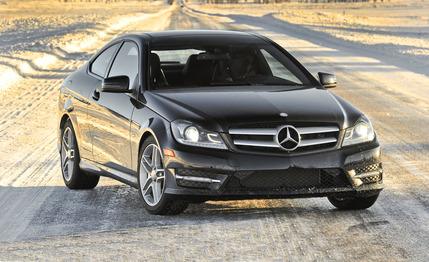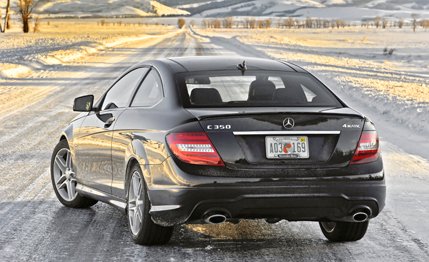
 Instrumented Test
Instrumented Test


We’ve previously compared Porsche’s model lineup to the Taco Bell menu in the way that the engine and chassis components are mixed and matched across the lineup. But Porsche is not alone in this approach. Mercedes-Benz—perhaps to an even greater extent—also drops a multitude of engine and powertrain fillings into its various chassis shells. The latest round of extra cheese is all-wheel drive for the C-class and E-class coupes, bringing the brand’s all-wheel-drive offerings to 21 models across 10 nameplates. Only the SLK, SL, and SLS AMG are excluded from the 4MATIC party.
The all-wheel-drive C coupe comes in just one flavor: C350 with an automatic transmission. Its engine is identical to the 3.5-liter found in the rear-wheel-drive C350 sedan and coupe, producing 302 hp at 6500 rpm and 273 lb-ft of torque at 3500 rpm. But the C350 4MATIC coupe is a unique combo; in the C sedan, all-wheel drive is for now offered only on the C300 with its less powerful 228-hp, 3.0-liter V-6. At the test track, the C350 4MATIC had a good showing: 0 to 60 mph in 5.3 seconds, 0.85 g of grip, and 70-to-0-mph braking in 160 feet.
To route the power to all four wheels, Mercedes-Benz uses an in-house design that integrates the transfer case into the seven-speed automatic transmission. In dry conditions, the power distribution is set at 45/55 front to rear; when the system detects slippage, a locking center differential controlled by a 37-lb-ft spring-loaded clutch handles any imbalance between the two axles, sending up to 70 percent of power in either direction if necessary. The system is supplemented by an electronic traction-control system that brakes individual wheels in the event of slippage. Mercedes-Benz says the latest 4MATIC setup carries only about a 150-pound weight penalty on most of its cars (121 pounds on this particular example), partly because the rear axles and differentials are downsized on the all-wheel-drive cars; that nominal power distribution results in less torque sent rearward, allowing for lighter-duty and lighter-weight components. The German manufacturer is proud to note that there is no EPA fuel-economy penalty on the C350 coupe; rear- and all-wheel-drive versions carry the same 19 mpg city, 28 highway ratings on their window stickers. We saw 22 mpg combined from our test vehicle.


And the system works pretty well. On a preview event, we drove a C350 4MATIC coupe equipped with winter tires, which are invaluable on any car in wintry conditions (all-wheel drive won’t shorten stopping distances, for example). With the stability-control system in its most lenient setting (it lacks a fully defeated setting), the C350 pulled from a stop on the snow without any detectable wheelspin. As equipped, it handled the white stuff without any trouble whatsoever, and the additional traction was noticeable on dry pavement in a later test car. Overall, it barely feels different from its rear-wheel-drive counterpart, and it behaves largely the same. There’s some understeer, and the ride is comfortable; like the rear-drive C350 coupe, it’s not a sports car. The steering is relaxed, although it comes alive once you get close to the car's limits. Also the same are the dimensions of both two-doors, including ride height.
The only differences: The all-wheel-drive C350 boasts a heated windshield-washer-fluid system and a 4MATIC badge on the interior. Oh, and it costs an additional $2000. Excepting the extra cost, the C350 4MATIC coupe offers some additional capability with little compromise.